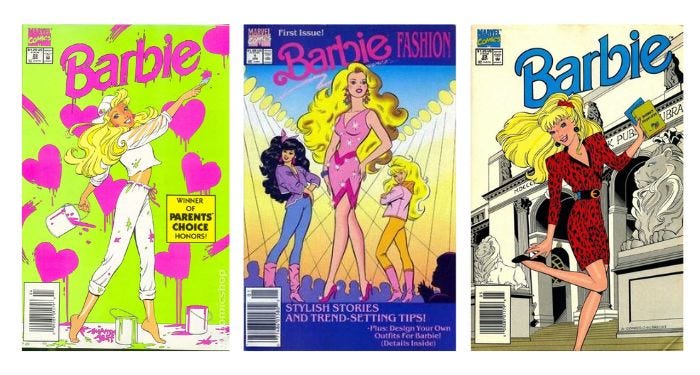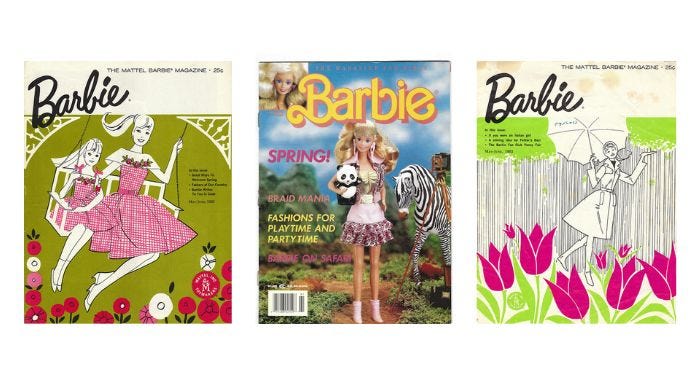
Barbie, Books, and Publishing for Young Readers
Barbie might be one of the first true franchises to cover everything. What began as a fashion doll in 1959 has grown into an industry with everything from non-doll toys like fashion plates to video games, games to television, and of course, the live-action film hitting screens this month. It should come as little surprise books have been part of the Barbie brand strategy from the beginning. Barbie books and comics began right alongside the doll and became a publishing boom in the ’80s, ’90s, and early ’00s. Mattel, the company that owns Barbie, found sales slumping during this time and found books and magazines one avenue to cash in during this era. Over 400 Barbie books have been published since the early 1990s.
Let’s take a look at some of the stand-alone, series, and comic books that have been part of the Barbie legacy. Note that these are not forms of media geared toward collectors, and they are about U.S.-based Barbie material. Collectors’ media and those outside the U.S. are worthy of their own deep dives.
Barbie’s First Book
The very first book to feature Barbie at the center of the story was published in January 1962. Here’s Barbie by Bette Lu Lawrence and Cynthia Maybee launched the series, which ran until 1965. It’s a little difficult to track down the full lineage of this series, but it appears to have included 12 books, including a cookbook, a mystery, and a romance.
Barbie and her family lived in Willows, Wisconsin, where she attended Willows High School. Of course, Ken makes an appearance in this series, and we begin to meet the extended Barbie world slowly, including best friend Midge (it would not be until 1968 we meet the first Black Barbie in this world, Christie). Barbie is into fashion, travels to places like New York City and Hawaii, and takes a job as a candy striper. The final story is especially interesting, given this was the downside of the career novel publishing storm for teens.
Barbie in Comics

The 1960s were the silver age of comics, and given the audience being reached by the Barbie chapter books — children and tweens between about 3 and 12 — it comes as little surprise that Barbie was an obvious candidate for the comic treatment. The comics were geared toward girls, and the first series, which ran for five issues, focused exclusively on the budding romance between Barbie and Ken. Their story fit right into the trend toward romance comics for this readership group at the time.
Where the initial Barbie book series featured a character depicted in a realistic manner — as much as you can call an illustration “realistic,” of course — the Barbie and Ken series of comics had Barbie and Ken depicted as dolls. They also appear much older than they do in the books. Together, the couple travel to Europe and become glamorous stage performers, play tennis, and do plenty of dancing.
It was not until 1991 that Barbie returned to the glossy comic pages, this time under the Marvel banner. Barbie ran for 63 issues until 1996, and at the same time, Marvel also published a series featuring the fashion icon in Barbie: Fashion. There were 53 issues, beginning in January 1991 and ending in 1995.
As both of those series wrapped up, Barbie was not left behind. There was a short, two-issue series showcasing Barbie and her Halloween preparation in October 1993 called Barbie: Halloween. Marvel also gave Barbie a single issue in October 1995 where she and her younger sister got to bond, Barbie and Baby Sister Kelly.
If Barbie Comics sound super exciting to you, maybe you’ll want to temper that with this look at the lackluster franchise from one of Book Riot’s comic experts.
Yes, There Was a Magazine

More than one magazine, in fact. The very first Barbie-themed magazine was published in the early 1960s from Mattel. The pages included stories that featured Barbie and her world, as well as the kinds of information and insights that would keep a young reader engaged. In May-June 1963, you could learn what it might be like to be an Italian girl and be part of the Barbie Fan Club Penny Fair; you could meet the new doll Francie in March-April 1966 (Francie was Barbie’s Mod-themed cousin); in July-August 1967, you could read about famous women in history and “Have a Singin’ Summer”; and in September-October 1967, you could make a paper dress and prepare for Halloween fun. It is not clear how long this magazine was published, though a dive through the internet and various auction sites put it at about a five-year run. You can peep the May-June 1964 issue over on YouTube from a collector.
The ’80s and ’90s were also the peak decades for magazines reaching children, tweens, and teens. Barbie: The Magazine for Girls launched in 1984, and it took the form of so many other tween-girl-angled magazines. While Barbie was front and center, the stories covered a range of topics of interest to the demographic. Issue one, for example, included a look at great gift ideas (including for your pets), fun hairstyles, and stories featuring Barbie herself. The stories included photodramas, featuring the toys themselves staging the story. There’s a fun YouTube video here diving into the issue, including many of the advertisements inside. At its peak, Barbie: The Magazine for Girls had a reported readership of over 60,000 every other month, or 15% of all girls in America between the ages of 5 and 12.
More Barbie Books
Let’s get back to some of the books, though. There have been so many, so it’s impossible to highlight every single one. Instead, let’s take a look at some of the more interesting Barbie books and when they hit shelves. I’ve also stuck with the canon Barbie work, meaning the offshoots like Generation Girl and Bratz. You might like to nerd out about the history of the former, though, and its lawsuit with Mattel.
The reason that Barbie inventor Ruth Handler came up with the doll is she noticed her children preferred playing with adult paper dolls than they did paper dolls depicting children. In the 1950s, there were no physical dolls that were made to look like adults. So it is somewhat amusing to know that Barbie herself also became a paper doll several times. You can track down vintage Barbie paper doll books even now, including her 1964 travel adventures, her 1978 superstar edition, and her continued superstar reign from 1989. There’s even a fun paper doll book from 1973 featuring Barbie, Francie, Kelley, and Skipper showing off their curly hair in Quick Curl Barbie.
Little Golden Books made stories more accessible and affordable after World War II, and Barbie, given her popularity and Mattel’s franchising prowess, had several of her own Little Golden Book editions, golden spine and all. Among the titles are The World of Barbie, a reprint of the first book published in 1962 and features the vintage images; Very Busy Barbie, where Ms. Barbie is late to an appointment since she was helping a sick friend; and a whole series of books highlighting Barbie’s relationships with cats, rabbits, and other animals. The Little Golden Books Barbie titles also include several classics adapted for young readers, including Cinderella, The Nutcracker, and Sleeping Beauty.
Barbie is nothing short of adventurous, and she had a whole series dedicated to just that in Adventures With Barbie, which ran from 1991 to 1993. These slightly older chapter books were written by authors like Suzanne Weyn, who might be recognizable as a still-publishing middle grade and YA author today. Some of Barbie’s adventures included The Phantom of Shrinking Pond, wherein Barbie and her friends hoped to turn her aunt’s old mansion into a children’s camp, but they’re faced with the reality of meeting a phantom there. There’s also Dancing the Night Away, wherein Barbie plans a charity dance to help support needy children, and at what should be the highlight of the event–her dance number with Ken–she’s confronted by a very jealous peer whose parents happen to be one of the event’s biggest potential donors.
Of course, no cultural icon would be without books that pay her and her world homage. Among them are Mondo Barbie: An Anthology of Fiction and Poetry edited by Lucinda Ebersole and Richard Peabody (1993), which include stories of Barbie being involved in a cult and experiencing substance use challenges, and the young adult nonfiction work by Tanya Lee Stone published in 2015, The Good, The Bad, and The Barbie: A Doll’s History and Her Impact on Us.
While there is a lot to say about the gender essentialism and whiteness when it comes to toys like Barbie, as well as the lengthy list of commentary to be made about her role in perpetuating specific standards of beauty and weight, one thing Barbie has done for girls (and boys and nonbinary children, too) is show that girls can be the star, the hero, and the full-time center of their worlds. She has done a little of everything, from being a fashionista to being a pilot; being the lead in Swan Lake to being a best friend; breaking up with her long-time boyfriend to coaching soccer, solving mysteries, and becoming a horse riding champion. The girl’s got an impressive as hell resume, as well as loads of lifelong fans, collectors, and stories to keep on sharing and inspiring the next generations of kids.
For Your Next Bar Trivia Night
How about some fun Barbie facts?
- Kelly used to be the name of Barbie’s baby sister. She was introduced in 1995 and “retired” in 2010. Do you know what happened to her in her retirement? She was renamed Chelsea. In 2011, when Chelsea was introduced, she was the new Kelly. In some of the older stories, her name seems to have also been spelled as Kelley.
- Barbie and Ken are not back together yet after their breakup in 2004. They’re still close and, as of writing, are just neighbors.
- Our friend Barbie also has a pilot’s license.
- Toy Story allegedly had a role for Barbie in the film, but that did not come to fruition. Ken was in the second Toy Story and his voice was in the third.
- Barbie has over 40 pets. These include what you might expect with dogs and cats, but she also keeps a zebra, panda, and lion cub.
I’ve linked to tons of fun reads throughout the piece, but here’s another great one to check out: Forever Young: After 30 Years, Barbie Has More Clothes, Friends, and Fans Than Ever (LA Times, 1989)
The comments section is moderated according to our community guidelines. Please check them out so we can maintain a safe and supportive community of readers!







Leave a comment
Become an All Access member to add comments